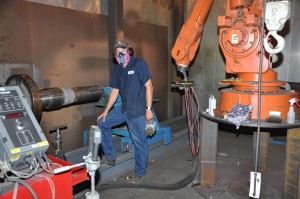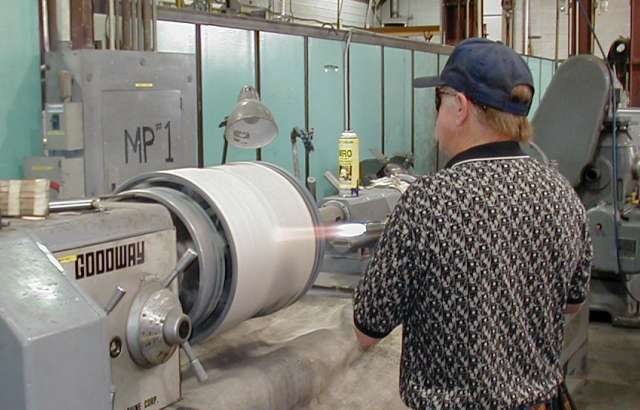Prime Machine offer premier Metal Spraying technologies of: HVOF, Twin Arc, and Thermal spraying
The Prime Machine Revolution of Metal Spraying: HVOF, Thermal Spray, and Twin Arc Systems
Sprayed materials include:
HVOF Metal spraying- Carbide Coatings
| Materials/ Chemistry |
Hardness | Bond Strength |
Application Data |
| Tungsten Carbide Cobalt WCCO |
63-66 RC | >10,000 PSI | •Pump seals •Rolls •Jet engine parts •Machinery wear parts |
| Chrome Carbide Nickel Chrome Cr3C2NiCr |
65 RC | >10,000 PSI | •Turbine inner nozzle supports •Turbine exhaust struts •Fuel rod mandrels •Exhaust valves |
| Tungsten Carbide Chrome WcCoCr |
64 RC | >10,000 PSI | •Pump shafts with corrosion |
HVOF – Metal & Alloy Coatings
| Materials/ Chemistry |
Hardness | Bond Strength |
Application Data |
| Cobalt Molybdenum Chromium CoMoCr |
50-55 RC | 9500 PSI | •Very dense and well bonded •Good for pump components, valve shafts and exhaust fan blades •Excellent fretting wear |
| Iron Chrome Molybdenum FeCrMo |
53 Rb | 7500 PSI | •Excellent for corrosive and sliding wear below 1200°F |
| Nickel Aluminum NiAl |
45 Rb | 6000 PSI | •Bond-coat for carbides and ceramics •Coating offers wear and oxidation protection |
| Copper Cu |
60 Rb | 4000 PSI | •Exceptionally dense and machinable •Restoration of worn and mis-machined copper and copper-alloy parts |
HVOF – Ceramic Coatings
| Materials/ Chemistry |
Hardness | Bond Strength |
Application Data |
| Aluminum Oxide AL203 |
68 RC | 5000 PSI | •Very Smooth, with high dielectric (600-900 V/Mil) |
Plasma Spray – Ceramic Coatings
| Materials/ Chemistry |
Hardness | Bond Strength |
Application Data |
| Aluminum Oxide Al2O3 |
RC-71 | 5000 PSI | •Dielectric covering, textile parts •Pump shaft (seal areas) |
| Chromium Oxide Cr2O3 |
RC-74 | 5000 PSI | •Very hard, very high corrosion protection •Sliding wear for chemical pump shaft wear |
| Aluminum Oxide Titanium Dioxide Al2O 3TiO2 |
RC-69 | 5000 PSI | •Anti-static, cylinder liners •Molds, sliding wear from fibers •Resistant to acids and alkalis •Many textile applications |
Plasma Spray – Carbide Coatings
| Materials/ Chemistry |
Hardness | Bond Strength |
Application Data |
| Tungsten Carbide WCCo |
60 RC | 7,500 PSI | •Machine wear •Jet engine parts •Sliding wear (metal parts) |
| Chrome Carbide Cr3C2NiCr |
46 RC | 5,000 PSI | •Promotes extreme resistance to wear at high temperatures •Good for hot gas and corrosion resistance •Useful up to 1600°F |
| Tungsten Carbide Chrome WCCoCr |
50 RC | 7,500 PSI | •Improved oxidation and corrosion protection over WCCO •Excellent low-temperature wear properties up to 900°F |
Plasma Spray – Metal & Alloy Coatings
| Materials/ Chemistry |
Hardness | Bond Strength |
Application Data |
| Nickel Aluminum NiAl |
45-55 RC | 8,000 PSI | •Highly resistant to oxidation and corrosion •Very machinable •Excellent bond-coat for ceramics |
| Copper Nickel Indium CuNiIn |
75 Rb | 3,500 PSI | •Indium is renowned for its lubricating properties •Outstanding resistance to motion wear such as fretting and galling |
| Molybdenum Chromium Silicon Cobalt MoCrSiCo |
45 RC | 6,500 PSI | •Coating exhibits outstanding resistance to wear and galling •Very suitable for applications where lubrication is a problem |
Plasma Spray – Thermal Barrier Coatings
| Materials/ Chemistry |
Hardness | Bond Strength |
Application Data |
| Magnesium Zirconia MgO2ZrO2 |
RC 31 | 2,600 PSI | •Thermal barrier coatings for combustion applications •Abrasive wear up to 1600°F |
| Zirconia Titania Yttria ZrO2TiO2Y2O3 |
RC 55 | 5,000 PSI | •Thermal barrier coating •High temperature hardness •Resitance to sulfidation, chlorinization and sodium hot corrosion |
Arc Spray – Metal Coatings
| Materials/ Chemistry |
Hardness | Bond Strength |
Application Data |
| Aluminum Al |
Rb 35-75 | 4,350 PSI | •Chemical and corrosion resistance •Electrical conductivity •Aircraft approved |
| Copper Cu |
Rb 37 | 7,200 PSI | •Extreme conductivity •Copper reclamation •Alternate to copper plating •Decorative coatings |
| Nickel Ni |
Rb 58 | 4,100 PSI | •Corrosion protection at high temperatures •Excellent machined surfaces •Aircraft approved |
| Tin Sn |
Rb 70 | 2,500 PSI | •Sputtering targets •Electrical contacts •EMI/RFI shielding |
| Zinc Zn |
Rb 61-72 | 1,300 PSI | •Excellent bonding to non-metallic surfaces •Corrosion •EMI/RFI Shielding |
Arc Spray – Alloy Coatings
| Materials/ Chemistry |
Hardness | Bond Strength |
Application Data |
| Inconel 718 NiCrMo |
RC 30 | 9,000 PSI | •Aircraft engine dimensional restoration •Acidic and hot gas corrosion resistant |
| Iron Chrome Aluminum FeCrAl |
Rb 88 | 7,000 PSI | •Good for build-up •Good machinability •Excellent wear resistance |
| Nickel AluminumNiAl |
Rb 78 | 9,800 PSI | •Bond Coat •Oxidation/abrasion resistance at high temperatures •Aircraft approved |
| 420 SS FeCrNiSi |
Rb 40-45 | 8,000 PSI | •Corrosion protection •Dimensional restoration |



